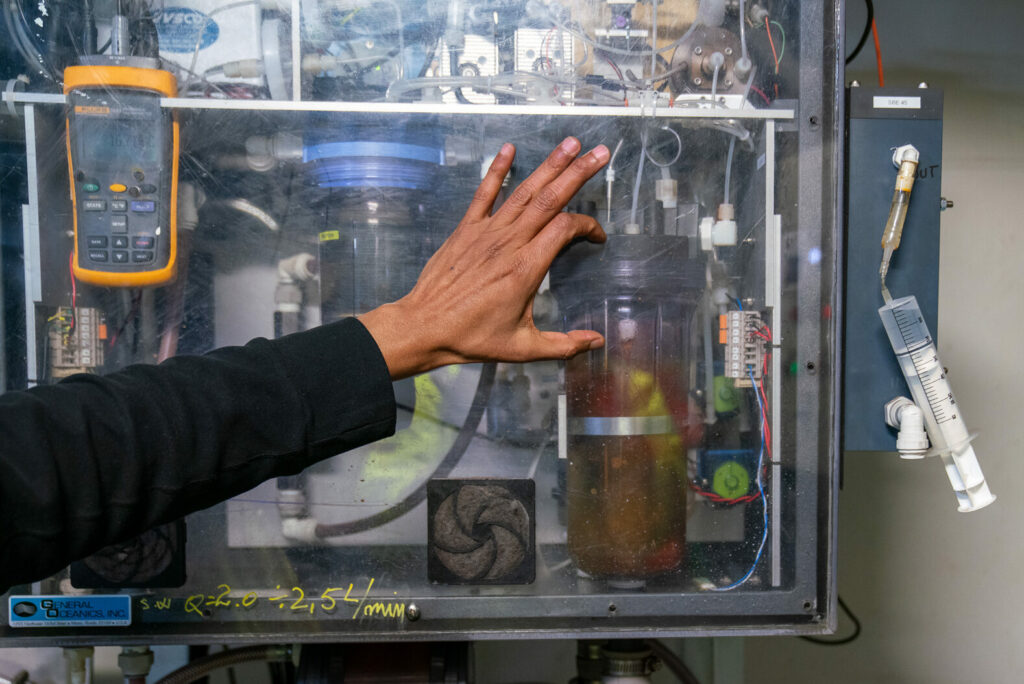Sea-Cargo Express combatting climate change
As we step aboard the Sea-Cargo Express during a port stop in Bergen, Norway, we meet Abdirahman M. Omar, Senior Researcher at NORCE. Omar oversees the measurements being conducted on the ship as part of the Integrated Carbon Observation System (ICOS) network. These measurements are used for understanding the exchange of CO₂ between the ocean and the atmosphere.
Deep in the heart of the ship’s engine room, surrounded by the hum of machinery, Omar explains how the advanced systems onboard are helping to gather climate-critical data, contributing to the broader ICOS mission of monitoring greenhouse gas emissions across Europe’s oceans, land, and atmosphere.
“We have been collaborating with Sea-Cargo since 2005, and in 2022, the Sea-Cargo Express took over from Trans Carrier, and is now equipped with an automatic sea surface measuring system – allowing us to continuously measure the partial pressure of CO₂ (pCO₂), along with temperature, salinity, and oxygen, as the ship sails between Trondheim and Aberdeen” Omar explains.


Abdirahman M. Omar, Senior Researcher at NORCE
Tracking CO₂ across the ocean
The Sea-Cargo Express, 119 meters long, sails through regions that provide valuable data on oceanic CO₂ dynamics. Its route crosses areas with distinct biogeochemical properties, from Norway’s fjords to the North Sea.
Norwegian fjords and coastal waters have very different carbon cycles, Omar explains. “They are affected by river water, water mixing, and biological activity, making them unique for studying how CO₂ is absorbed or released.” The Sea-Cargo Express travels through areas with changing salinity and seasonal CO₂ patterns. “For example, the northern North Sea absorbs CO₂ from the air, acting as a carbon sink. But in summer, the southern North Sea releases CO₂ back into the atmosphere.”
Real-time monitoring
Omar leads us to the ship’s monitoring system, an advanced array of pumps and sensors that automatically collects data as the vessel sails along its route. “The system continuously pumps in seawater at 4 meters below the surface to measure the levels of CO₂, oxygen, salinity, and temperature,” he says, while pointing to an acrylic box filled to the brim with tubes and sensors. “By comparing CO₂ levels in the water and the air above, we can track the balance between them.”
This real-time data is important for understanding how much CO₂ the ocean absorbs or releases. “In northern regions, particularly along Norway’s coast, the ocean acts as a major carbon sink. However, conditions vary greatly between different parts of the sea, which is why continuous monitoring is vital,” Omar adds.


Omar explaining how the advanced equipment monitors CO₂ in the sea below the Express
Contributing to global climate efforts
Omar’s research is part of a broader international collaboration aimed at understanding the global carbon cycle. “We’re working within a global network that estimates CO₂ flux between the ocean and the atmosphere,” he says. “Our data helps build models that provide global insights into how much CO₂ the oceans are absorbing or releasing.”
This information is invaluable to international efforts to combat climate change. “The data we collect feeds into the United Nations’ work to monitor global emissions and set climate targets. By understanding how much CO₂ the ocean absorbs, we can refine carbon budgets and improve climate predictions.”
Ocean acidification: A growing concern
As Omar explains, their research not only tracks CO₂ but also monitors ocean acidification. “Seawater is naturally alkaline, but as it absorbs more CO₂, it becomes less alkaline,” he says. “This has serious implications for marine life, especially organisms that rely on calcium carbonate to build shells and skeletons.”
Understanding these changes is key to predicting the future impacts of climate change. “It’s not just about tracking emissions, but also about understanding how CO₂ affects the chemistry of the ocean and the organisms living in it,” Omar notes.

Supporting global sustainability goals
The work aboard the Sea-Cargo Express actively contributes to the United Nations’ sustainability agenda by providing critical data that informs climate policies and environmental strategies. By tracking CO₂ exchange between the ocean and atmosphere, and monitoring ocean acidification, this research directly supports efforts to understand and mitigate climate change. The collected data improves scientific models and supports international decision-makers in setting more precise emissions targets.

Looking to the future
As we wrap up our visit, it’s clear that the work of Omar and his team plays a crucial role in the fight against climate change. “The ocean is a massive carbon sink, and understanding its role in the global carbon cycle is essential for predicting how our climate will change in the future,” Omar reflects.
The Sea-Cargo Express plays an important role in transporting goods that keep the world moving, but it’s also carrying something even more impactful: essential data. As it navigates the seas between Norway and Scotland, it collects information that helps scientists and policymakers worldwide address the greatest challenge facing our planet.
